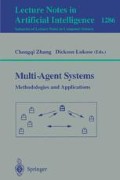Abstract
In this paper, the author describes a graphical conceptual modelling language called MODEL-ECS that is used to model the components of a mobile agent. The use of this language to model the PROJECTION COMPONENT of the Perception Mechanism of a mobile agent is demonstrated. This modelling language uses conceptual structures (i.e., Conceptual Graphs, Actor Graphs, and Problem Maps) as its primitive modelling constructs. The Knowledge Analysis and Design Support (KADS) conceptual modelling principles are adopted in building the Knowledge Sources and the Problem Solving Methods (PSMs) for constructing the components of a mobile agent. There are three main reasons (resulting in three major advantage) for using MODEL-ECS to construct the components of a mobile agent: (1) the executable components in the form of PSMs are much easier to transport from one Agent Server to the next, because you only have to send a flat file consisting of the conceptual structures that make up the PSM; (2) it is much easier to manipulate conceptual structures to construct a PSM, rather then writing a program; (3) the conceptual structures are specifically designed to maintain their current value, thus, enabling the PSMs of a mobile agent to be suspended at any time, so the agent can be transported to the next location, and it can commence execution from where it left off. These three advantages are crucial to the successful implementation of a robust extendable mobile agent architecture.
Preview
Unable to display preview. Download preview PDF.
References
Cockburn, D., and Jennings, N. R., (1996). ARCHON: A Distributed Artificial Intelligence System for Industrial Applications, Foundations of Distributed Artificial Intelligence, G. H. P. O'Hare and N. R. Jennings (Eds.), John Wiley & Sons, Inc., New York, 1996.
Cross, T. and Lukose, D., (1994). The representation of non-linear hierarchical executable plans, in Proceedings of the 1st Australian Workshop on Conceptual Structures, Armidale, N.S.W., Australia, pages 58–69.
Decker, K. S., (1996). TAEMS: A Framework for Environment Centered Analysis and Design of Coordination Mechanisms, Foundations of Distributed Artificial Intelligence, G. H. P. O'Hare and N. R. Jennings (Eds.), John Wiley & Sons, Inc., New York, 1996.
Fikes, R. E., and Nilsson, N. J., (1971). STRIPS: A new approach to the application of theorem proving to problem solving, Artificial Intelligence 2(3-4):189–208.
Fischer, K., Muller, J. P., and Pischel, M., (1996). AGenDA — A General Testbed for Distributed Artificial Intelligence Applications, Foundations of Distributed Artificial Intelligence, G. H. P. O'Hare and N. R. Jennings (Eds.), John Wiley & Sons, Inc., New York, 1996.
Lukose, D. (1991). Conceptual Graph Tutorial, Department of Computing and Mathematics, School of Sciences, Deakin University, Geelong, Australia, 3217.
Lukose, D., (1993). Executable Conceptual Structures, in G.W. Mineau, B. Moulin and J.F. Sowa (eds.), Conceptual Graphs for Knowledge Representation, Lecture Notes in Artificial Intelligence (699), Springer-Verlag, Berlin.
Lukose, D., (1995). Using Executable Conceptual Structures for Modelling Expertise, in Proceedings of the 9th Banff Knowledge Acquisition For Knowledge-Based Systems Workshop, Banff Conference Centre, Banff, Alberta, Canada, February 26 — March 3, 1995, Paper No: 8.
Lukose, D., (1996). MODEL-ECS: Executable Conceptual Modelling Language, in Proceedings of the 10 Banff Knowledge Acquisition For Knowledge-Based Systems Workshop, Banff, Alberta, Canada, November 1996.
Lukose, D., Cross, T., Munday, C., and Sobora, F., (1995a). Operational KADS Conceptual Model using Conceptual Graphs and Executable Conceptual Structures, in Proceedings of the International Conference on Conceptual Structures (ICCS'95), USA.
Munday, C., Daengdej, J., Cross, T., and Lukose, D., (1996). Motivation and Perception Mechanisms in Mobile Agents for Electronic Commerce, in Lecture Notes in Artificial Intelligence, Distributed Artificial Intelligence — Architecture and Modelling, edited by Chengqi Zhang and Dickson Lukose, Springer Verlag Publishers, 1996.
0'Hare, G. M., (1996). Agent Factory: An Environment for the Fabrication of Multiagent Systems, Foundations of Distributed Artificial Intelligence, G. H. P. O'Hare and N. R. Jennings (Eds.), John Wiley & Sons, Inc., New York, 1996.
O'Hare, G. M., and Jennings, N. R., (1996). Foundations of Distributed Artificial Intelligence, G. H. P. O'Hare and N. R. Jennings (Eds.), John Wiley & Sons, Inc., New York, 1996.
Sommaruga, L., Avouris, N. M., and van Liedekerke, M. H., (1996). The Evolution of the CooperA Platform, Foundations of Distributed Artificial Intelligence, G. H. P. O'Hare and N. R. Jennings (Eds.), John Wiley & Sons, Inc., New York, 1996.
Sowa, J.F., (1984). Conceptual Structures: Information Processing in Mind and Machine, Addison Wesley, Reading, Mass., USA.
Steiner, D. D., (1996). IMAGINE: An Integrated Environment for Constructing Distributed Artificial Intelligence Systems, Foundations of Distributed Artificial Intelligence, G. H. P. O'Hare and N. R.Jennings (Eds.), John Wiley & Sons, Inc., New York, 1996.
Wooldridge, M. J., and Jennings, N. R., (1994). Intelligent Agents, Lecture Notes in Artificial Intelligence (890), Springer Verlag, Berlin, 1994.
Author information
Authors and Affiliations
Editor information
Rights and permissions
Copyright information
© 1997 Springer-Verlag Berlin Heidelberg
About this paper
Cite this paper
Lukose, D. (1997). Modelling extendible mobile agents. In: Zhang, C., Lukose, D. (eds) Multi-Agent Systems Methodologies and Applications. DAI 1996. Lecture Notes in Computer Science, vol 1286. Springer, Berlin, Heidelberg. https://doi.org/10.1007/BFb0030080
Download citation
DOI: https://doi.org/10.1007/BFb0030080
Published:
Publisher Name: Springer, Berlin, Heidelberg
Print ISBN: 978-3-540-63412-6
Online ISBN: 978-3-540-69540-0
eBook Packages: Springer Book Archive

